TRIP REPORT: LONG ISLAND & CAPE COD
I am just back after 8 days of traveling through the Northeast: Long Island and Cape Cod. Susan has a niece who, in classic Wide-Eyed-Innocent-From-Ohio fashion, decided to seek fame and fortune in The Big Apple immediately upon graduation from college last June. Her dutiful and supportive Mom and Dad—not without reservations about the safety of their daughter but resigned to the idea that she was indeed growing up— ferried her to the Astoria section of Queens. This location is legally encompassed by the boundaries of The Big Apple, though it’s a far cry from what people in the outer boroughs refer to “The City,” i.e., Manhattan.
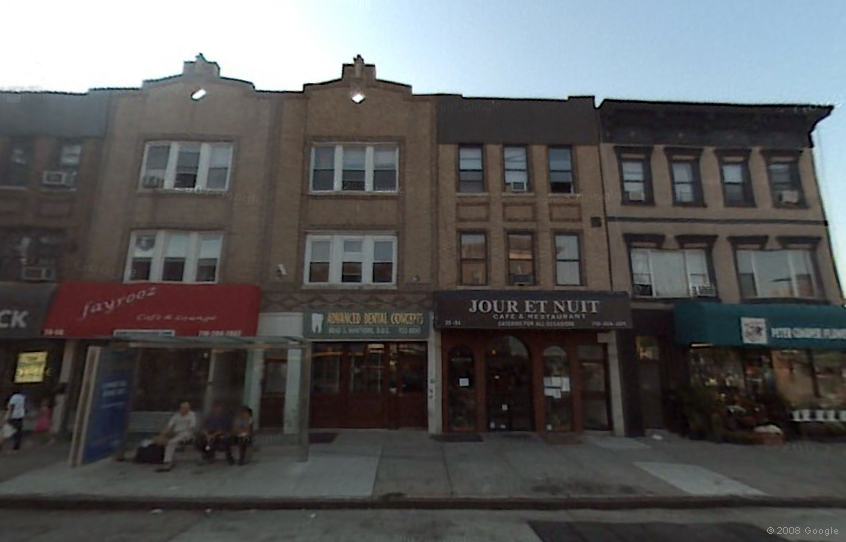 She
found a place to live, again, classically, through contacts. Her brother’s wife had a friend who had a
classmate who knew someone, etc., etc., so Niece ended up as one of three girls
in a third-floor walk-up over a dentist’s office on Steinway Street—yes, the
street is named after the piano company, that’s where they’re made.
She
found a place to live, again, classically, through contacts. Her brother’s wife had a friend who had a
classmate who knew someone, etc., etc., so Niece ended up as one of three girls
in a third-floor walk-up over a dentist’s office on Steinway Street—yes, the
street is named after the piano company, that’s where they’re made.
The
building certainly dates from the 1920’s or before, and has been carved up into
apartments that almost certainly don’t meet whatever code provisions apply to
apartments; but nobody in New York (least of all the authorities) gives a damn
about the code. It’s hard enough just
finding a place to live in New York; you take what you can get. I was amazed that Niece managed it so
quickly and found such a suitable place. Even though it’s a firetrap
that smells of smoke, sweat, and miscellaneous hormones, even 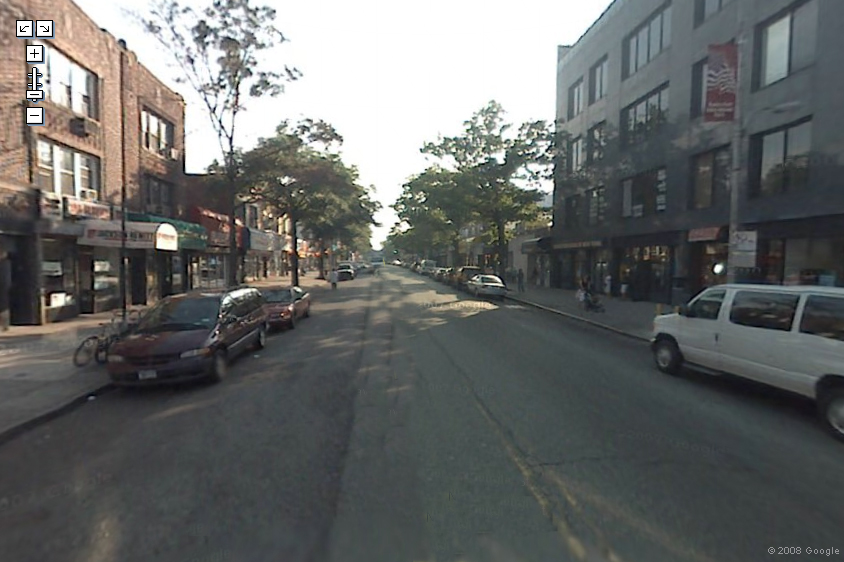 though it hasn’t
had an adequate cleaning since the Johnson administration, even though it has
to be reached by a 20-inch-wide staircase with two sharp turns, and even though
the view out the kitchen window is entirely composed of fire escapes and
rooftop water towers, it could be far, far worse. Niece did a good job ferreting
this one out. Her mother expressed
politely-repressed horror at the condition of the place (“I’d never let a
rental apartment I owned get that dirty!”) which was as much an expression of
ignorance of the realities of city life as it is of her inbred Ohio standard
for “tolerable levels of filth.”
though it hasn’t
had an adequate cleaning since the Johnson administration, even though it has
to be reached by a 20-inch-wide staircase with two sharp turns, and even though
the view out the kitchen window is entirely composed of fire escapes and
rooftop water towers, it could be far, far worse. Niece did a good job ferreting
this one out. Her mother expressed
politely-repressed horror at the condition of the place (“I’d never let a
rental apartment I owned get that dirty!”) which was as much an expression of
ignorance of the realities of city life as it is of her inbred Ohio standard
for “tolerable levels of filth.”
Nor is it in a slum, though Mom and Dad think it is. Astoria is a pretty decent neighborhood and nowhere near a slum, again by the standards of New York. The clichéd term for it would be “colorful,” or perhaps “diverse,” if you want to be Politically Correct. Astoria was for a long time one of the major concentrations of Greek immigrants in the outer boroughs. While there are still plenty of Greek names to be seen on shops, and it’s easy to find styfado and spanikopita in local restaurants, there are now very large contingents from Arabic-speaking parts the Middle East as well. Many Muslims live there, attested to by signs advertising halal meat. There are also not a few Jews, because you can find Kosher meat as well.
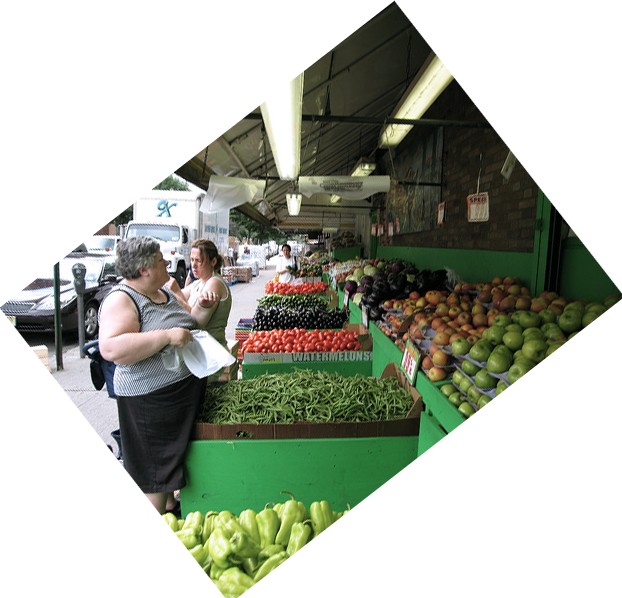 Astoria
is the sort of neighborhood where
there’s a more or less complete absence of one-stop-shopping. There are supermarkets, to be sure, but they’re
small places, nothing like the gargantuan suburban supermarkets found everywhere
else in the US. You won’t find stores in New York with several acres of floor
space. Open-air fruit stands, small butcher shops—and most especially stores
selling fresh fish—have simply vanished
from most of the rest of the USA. But in New York land is so costly that even mammoth chain groceries
can’t afford to build.
Astoria
is the sort of neighborhood where
there’s a more or less complete absence of one-stop-shopping. There are supermarkets, to be sure, but they’re
small places, nothing like the gargantuan suburban supermarkets found everywhere
else in the US. You won’t find stores in New York with several acres of floor
space. Open-air fruit stands, small butcher shops—and most especially stores
selling fresh fish—have simply vanished
from most of the rest of the USA. But in New York land is so costly that even mammoth chain groceries
can’t afford to build.
So New York City in general, and especially neighborhoods like Astoria, have what they’ve always had: innumerable tiny specialized stores for the basic necessities. Most of them have outdoor stands because sidewalk space is free and the display tempts passers-by. Because their stock is small it’s rotated rapidly. The stuff they sell is delivered the very day it’s sold, coming in from the farms of New Jersey and Long Island, the Lower East Side meat district, or the Fulton fish market. It's as fresh as anything in any suburban farmer’s market. In this respect New York has stayed behind the curve, so to speak, and hence are now in front of it again: the “local foods” movement and the shift away from huge all-in-one stores now being touted by the Greenies is essentially what almost every New York neighborhood has and always has had. Having grown up in a neighborhood not too unlike Astoria, I was pleased to see that such places still exist.
When we came down from Niece’s apartment I remembered one of the reasons I left New York. We’d found the apartment easily, and lo, there was a parking space right in front of the building (this is nearly unheard of and I considered it a Good Omen. I was wrong). I bought a parking ticket at the machine on the corner, placed it on my dashboard and we went up to her apartment for an hour. When I came down, there was a guy in a NYC Parking Nazi uniform, writing me a ticket. Why? Because I had placed the ticket in my window UPSIDE DOWN, a major no-no, it seems.
I had an hour left on the ticket, but the S.O.B. was adamant. In broken English (he was from Nigeria or Congo, or someplace like that) he explained he had started writing the ticket; no, he couldn’t simply stop writing it; no, he had no way to cancel it. If I liked I could send in my $35 fine with a letter and the ticket and explain, and MAYBE the Chief Parking Nazi would give me a break. Probably not, but it was worth a try. In my experience, the most effective part of any city government is the Parking Nazi Division. They have a responsibility to bring in tons of cash, and they do that with near 100% efficiency. I suppose I should be glad they didn’t tow the car away or boot it: that’s what the District of Columbia would have done.
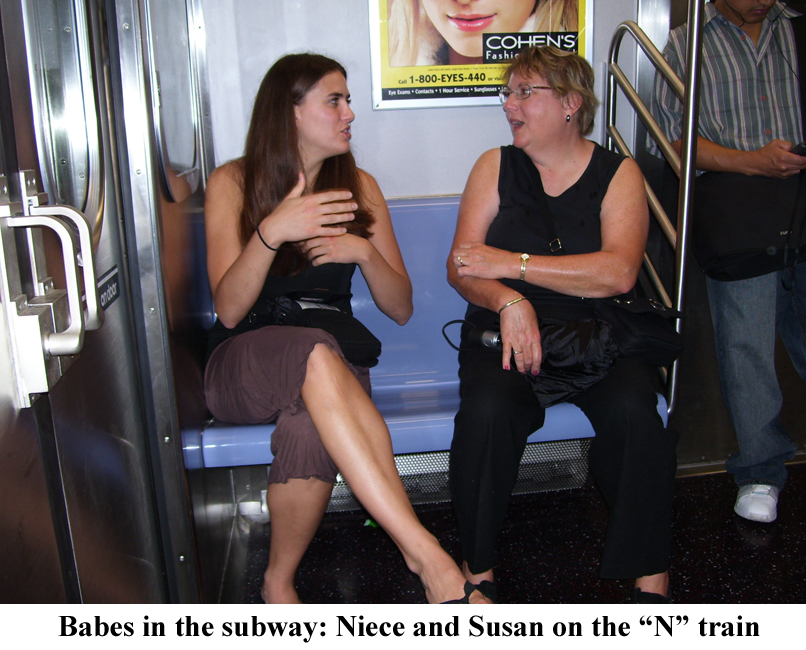 After our fruitless argument with the
Parking Nazi I moved the car to a nearby municipal parking lot and bought a
long-term ticket, carefully placed it
right-side-up in my window, and off we trooped to the subway, to go to midtown
Manhattan. Steinway Street is remarkably
convenient to The City, thanks to the subway system. The apartment is only a block or two from the
“N” train, which in 35 minutes or less goes to Times Square, Herald Square, 59th Street and 5th Avenue (where Niece is currently working) and in a
little more time can reach anywhere anyone wants to be. The Long Island Railroad runs from Penn
Station out to her brother’s house in Sound Beach, Long Island. New Yorkers—Niece isn’t one yet but she will
be soon if she stays—have no need for cars, even if they have a place to park
them, which almost nobody has.
After our fruitless argument with the
Parking Nazi I moved the car to a nearby municipal parking lot and bought a
long-term ticket, carefully placed it
right-side-up in my window, and off we trooped to the subway, to go to midtown
Manhattan. Steinway Street is remarkably
convenient to The City, thanks to the subway system. The apartment is only a block or two from the
“N” train, which in 35 minutes or less goes to Times Square, Herald Square, 59th Street and 5th Avenue (where Niece is currently working) and in a
little more time can reach anywhere anyone wants to be. The Long Island Railroad runs from Penn
Station out to her brother’s house in Sound Beach, Long Island. New Yorkers—Niece isn’t one yet but she will
be soon if she stays—have no need for cars, even if they have a place to park
them, which almost nobody has.
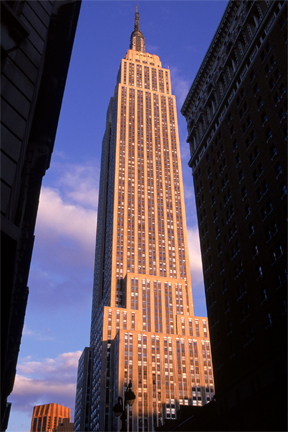 We wanted
to go to the Empire State Building. I
grew up in New York City, but like all natives, had never gone there until I
was well into my 30’s; and it had been at least 20 years since that last trip. We hoofed it from Herald Square two blocks to
the entrance, there to find hordes of tourists, all intent on doing the same
thing. There was an hour and a half wait to get through the airport-like
Security barrier just to buy tickets.
We wanted
to go to the Empire State Building. I
grew up in New York City, but like all natives, had never gone there until I
was well into my 30’s; and it had been at least 20 years since that last trip. We hoofed it from Herald Square two blocks to
the entrance, there to find hordes of tourists, all intent on doing the same
thing. There was an hour and a half wait to get through the airport-like
Security barrier just to buy tickets.
They now have X-ray machines and metal detectors, and they confiscated my Camillus pocketknife, though they did return it when I exited and showed them the claim check. I found out, however, that a small and very sharp Boker pocketknife with a ceramic blade and plastic grips does not trip a magnetometer…a useful datum point for anyone who needs it, and I will say no more on the subject.
After an hour and a half of the Disneyland Rope-A-Dope Shuffle up and down the line, we finally reached the ticket office, where a sign announced that the 86th floor observation platform was closed due to bad weather and poor visibility (it had started to rain while we were in line). The ticket clerk denied all responsibility, and while she didn’t quite say she didn’t give a damn if we bought tickets or not (the tone of her voice strongly suggested that was her attitude) she did point out that the 102nd floor was open, if we cared to spend another $15 each to go there…and of course, the weather there was such that we wouldn’t be able to see anything at all, anyway.
Not only that, but there was another hour-and-a-half long line waiting to go up to see whatever could be seen. We could, if we liked, pay yet another $25 each to bypass the line; if we went Whole Hog and bought the 102nd floor and “Express” tickets, we’d have been nicked for $60 EACH! Needless to say, we bagged the whole thing, went to a nearby Starbucks (unfortunately, New York City isn’t entirely immune from the cultural infections that plague the USA…there was a McDonald’s across the street, as well) and got back on the “N” train to bring Niece back to her hovel.
Back at the hovel, we decided to have lunch at a local Czechoslovakian beer garden (Astoria is a very diverse area) of which Niece had heard good things. We tromped through the Mean Streets of Astoria and eventually found it. A nice place, especially if you like Pilsener and kielbasa (in Czech it’s spelled differently but it’s the same thing) and sauerkraut. Lunch for three was a measly $60, which by the standards of New York City is dirt cheap.
Niece was coming with us out to her brother’s place in Sound Beach. Nephew is a graduate student at Stony Brook, and he and his wife are renting a cute little cottage while he works on his PhD and she works for a local bank. Nice place, much nicer than where I lived as a graduate student. My wife and I stayed in a local hotel: at my age I don’t sleep on people’s couches if I can avoid it. Once you get into Suffolk County beyond the metastasizing suburbs, Long Island is a pretty place. Very agricultural, and much to my surprise a lot of the agriculture is wineries! I hadn’t been that far out for decades, and in the interim apparently someone a) figured out how to grow wine grapes in the rather harsh local climate; and b) subsidized wine-making on a huge scale, because there are large and small vineyards all the way out almost to Montauk and Orient Points. Of this, more below. Sound Beach is a very pleasant town as is nearby Port Jefferson, a harbor town on Long Island Sound, where we had dinner that first night. We spent a day among the wineries (of which more below) and visiting the very pretty tourist town of Greenport.
In addition to agriculture, LI has become a tourist and recreational area. The old fishing and whaling villages along the Sound have more or less successfully transformed themselves into smaller versions of Cape Cod and Martha’s Vineyard. Commercial fishing must still go on, I suppose (though of course no whaling, which died out in the 1920’s) but pleasure boats, cruise boats, and ferries are the bulk of the Sound’s marine traffic nowadays. The towns that once were composed of smelly fish processing plants, ship chandlers, and ropewalks now are the locations for fashionable restaurants, clam bars, marinas, gift shops (God Almighty, are there gift shops), ice cream parlors, art galleries, and B&B’s. Much cleaner businesses than gutting fish or rendering blubber: and probably a good deal more profitable.
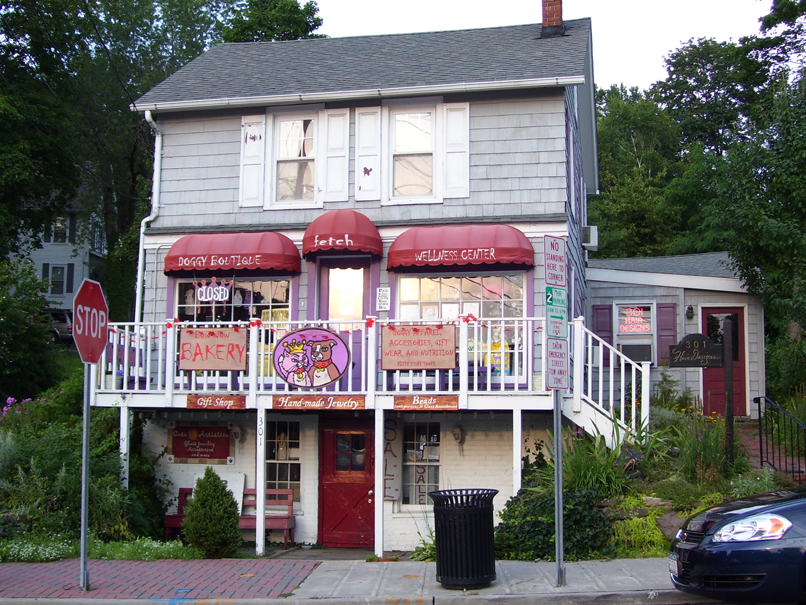
As is always the case where money abounds, there are people who’ll spend it on things that make you stop and think, sometimes, if there really is any limit to human stupidity. I present as Exhibit A, the Doggie Emporium in Port Jefferson. This is a place where dogs—yes, dogs—can get a massage; get their hair styled (301 different styles are on offer) and presumably get pedicures ( I know you can’t give a dog a manicure, but should that be “peticure”?) and—I swear I not making it up, just look at the picture—designer clothing. If people have the disposable income and the disposition to dispose of it in this way, running a dog clothing store-cum-massage parlor is as honest a way of sucking a buck out of them as any, but…even though I’m a Dog Person, I have never dressed my dogs up in anything but a collar and a leash. (Tycho would certainly look distinguished in a tux, but he’d bite me if I tried to put one on him, and I wouldn’t blame him a bit.) The old-time whaling captains and cod fishermen who sailed in and out of Greenport would approve of the commercial spirit of the founder of this boutique, but probably they’d also get a hearty laugh out of the customers.
 Greenport was our lunch stop—all the seafood we had on Long
Island was terrific—on the day we spent touring wineries. Cornell University has an oenological
station in the middle of the Wine Region, part of their Extension Service.
Greenport was our lunch stop—all the seafood we had on Long
Island was terrific—on the day we spent touring wineries. Cornell University has an oenological
station in the middle of the Wine Region, part of their Extension Service.
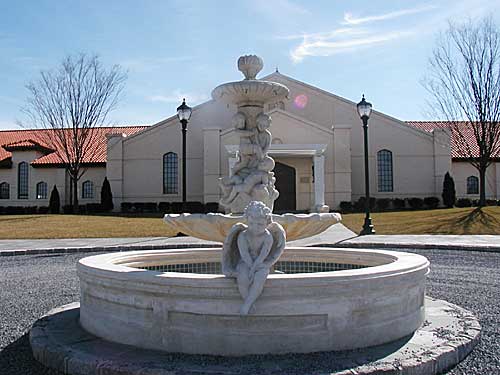 We
made it to three wineries, among which much the most impressive (taht is, the winery,
not the wines: uniformly the wines were undistinguished…more to the point, they were
indistinguishable) was Raphael Vineyards. This place is built to resemble a Tuscan villa on a grand scale, and has
a tasting room larger than the Catholic
We
made it to three wineries, among which much the most impressive (taht is, the winery,
not the wines: uniformly the wines were undistinguished…more to the point, they were
indistinguishable) was Raphael Vineyards. This place is built to resemble a Tuscan villa on a grand scale, and has
a tasting room larger than the Catholic 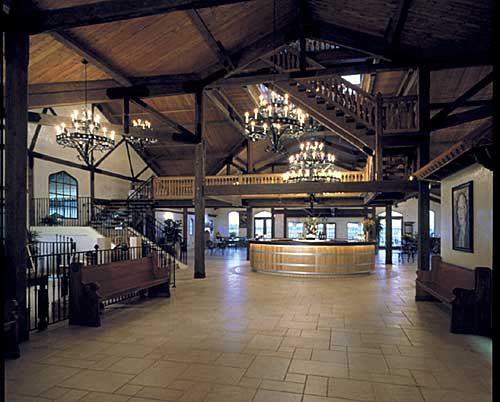 church I attended as a kid. I can’t imagine how much money it cost to build Raphael, but it had
to be well over $5 million just for the buildings, not to mention the land, the
plants, the labor of growing vines, etc. There is no possibility whatever that it can be turning a profit, even
ten years after its construction, and no matter what level of subsidy it gets
from the taxpayers of New York. No way.
church I attended as a kid. I can’t imagine how much money it cost to build Raphael, but it had
to be well over $5 million just for the buildings, not to mention the land, the
plants, the labor of growing vines, etc. There is no possibility whatever that it can be turning a profit, even
ten years after its construction, and no matter what level of subsidy it gets
from the taxpayers of New York. No way.
There’s so much tied up in capital investment
that I have to wonder if it’s really a winery at all, or might be some sort of
huge tax dodge or money-laundering operation. I’m no businessman. While I’m certain that
this place has impeccable financial records, if I were one of 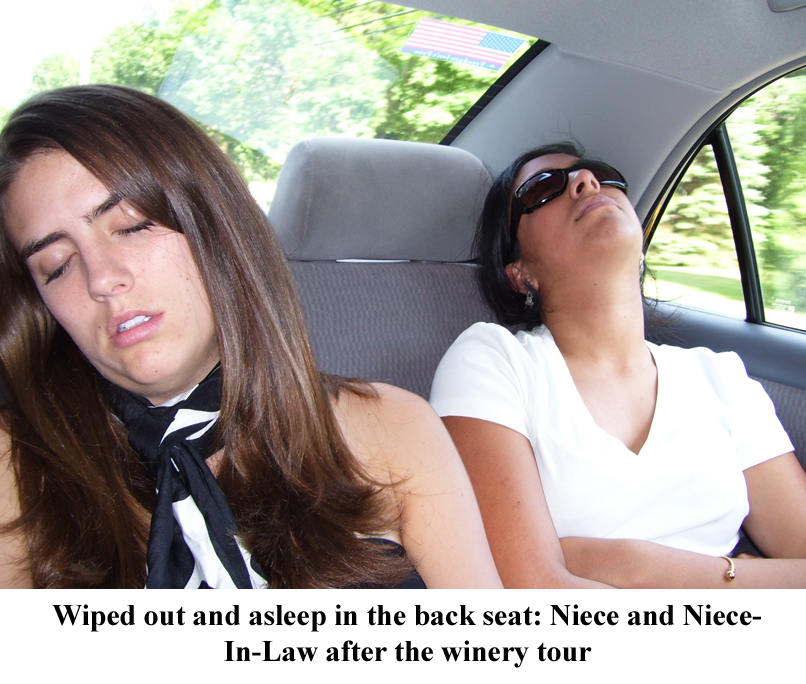 the government
goons who audit them, I’d wonder what was really going on. But beautiful it is, no question. We took our mediocre wines out onto a tiled
plaza overlooking the vines on a glorious day. The only thing lacking to make it a picture-perfect replica of Tuscany
was a few Lombardy poplars. Coming back from the vineyard tour, Niece and
Niece-In-Law were wiped out and snoozed in the back seat of my Corolla.
the government
goons who audit them, I’d wonder what was really going on. But beautiful it is, no question. We took our mediocre wines out onto a tiled
plaza overlooking the vines on a glorious day. The only thing lacking to make it a picture-perfect replica of Tuscany
was a few Lombardy poplars. Coming back from the vineyard tour, Niece and
Niece-In-Law were wiped out and snoozed in the back seat of my Corolla.
The next day was up-and-at-‘em bright and early. We had reservations for the 1:00 ferry from Orient Point (the eastern-most tip of Long Island) to New London, Connecticut. This shortcut saved us hours of driving, and was well worth the modest cost.
 Along the way we stopped in Greenport again
to have another superb seafood lunch. Chatting with the waitress I mentioned that Long Island was much more
like New England than it was New York. She agreed, and then commented that“Everything here is really like New
England,” and lowering her voice, she confided in a semi-whisper, “They even
have people who are Red Sox fans! ” I haven’t followed baseball since
the Dodgers abandoned Brooklyn, but even I recognized that this was the wildest and blackest heresy that could be
committed in Yankees territory. She was
right to speak the Name Of Evil in a low voice, lest merely saying it summon up
a demonic Terry Francona out of a puff of smoke.
Along the way we stopped in Greenport again
to have another superb seafood lunch. Chatting with the waitress I mentioned that Long Island was much more
like New England than it was New York. She agreed, and then commented that“Everything here is really like New
England,” and lowering her voice, she confided in a semi-whisper, “They even
have people who are Red Sox fans! ” I haven’t followed baseball since
the Dodgers abandoned Brooklyn, but even I recognized that this was the wildest and blackest heresy that could be
committed in Yankees territory. She was
right to speak the Name Of Evil in a low voice, lest merely saying it summon up
a demonic Terry Francona out of a puff of smoke.
The ferry ride was quiet and relaxed, but the ferry itself had made some voyages in its day that weren’t so calm. We rode her as Cape Henlopen, but that wasn’t her original name: she was
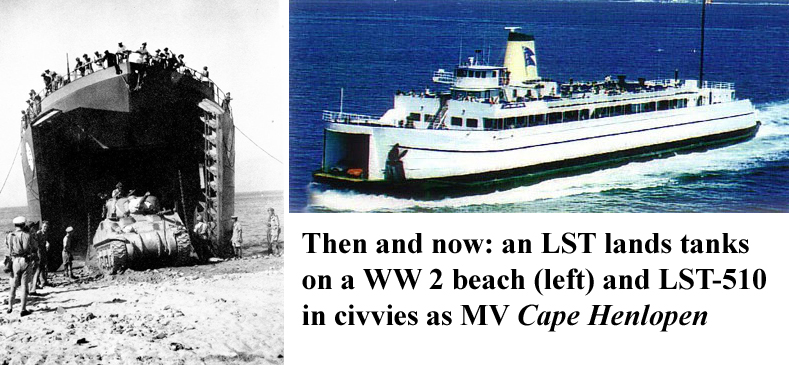
originally launched in 1944 as LST-510. On June 1, 1944, she embarked 200 men and 70 tanks of the 29th Infantry Division and transported them to Omaha Beach, landing them 8 hours after the initial assault. Renamed U.S.S. Buncombe County after the war, she was decommissioned by the Navy in 1958 and sold into ferry service. She originally was used in the Chesapeake Bay, and now, old enough to collect Social Security, she’s plying the waters of Long Island Sound. Cape Henlopen is the only remaining D-Day veteran ship still in service; and almost certainly the only ferryboat to have a battle star in her record. Compared to tanks and infantrymen under fire, hauling Toyotas and Volvos between Orient Point and New London must be pretty dull. In recognition of her war service, she flies a French Tricolor flag on her bow. After landing at New London (and damn it, I didn’t see a single submarine there!) we tootled on up US 1, and thence to Dennis Massachusetts, where we spent three days with some old friends.
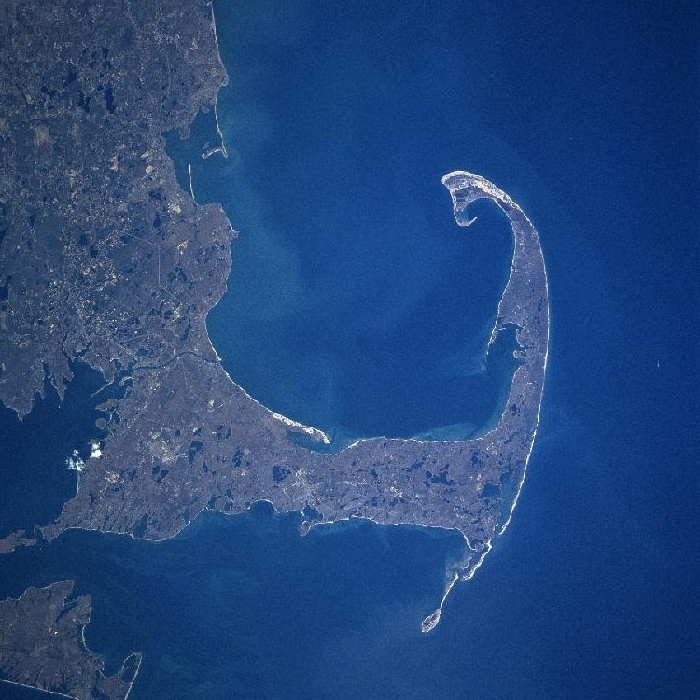
Cape Cod is more or less The Vacation Capital Of The Land Of 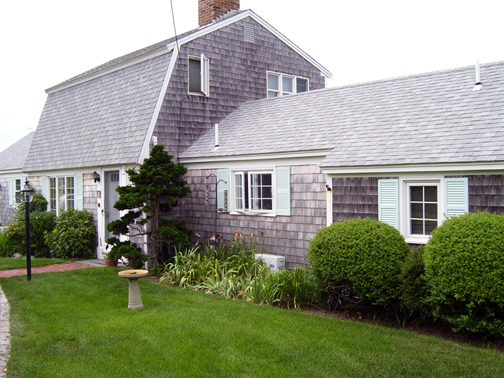 Liberals, but nevertheless it's a nice place, and if they didn't have so many damned Democrats in Massachusetts, it would be even nicer. The water on the Atlantic Ocean side is so cold that seagulls get frozen feet, and the side of the Cape that faces Cape Cod Bay isn't much warmer. So we didn't go swimming, though I did see hardy souls who ventured into the Bay. I once tried the ocean side at Nauset Beach some years ago, and almost had to go to the emergency room with frostbite...in August.
Liberals, but nevertheless it's a nice place, and if they didn't have so many damned Democrats in Massachusetts, it would be even nicer. The water on the Atlantic Ocean side is so cold that seagulls get frozen feet, and the side of the Cape that faces Cape Cod Bay isn't much warmer. So we didn't go swimming, though I did see hardy souls who ventured into the Bay. I once tried the ocean side at Nauset Beach some years ago, and almost had to go to the emergency room with frostbite...in August.
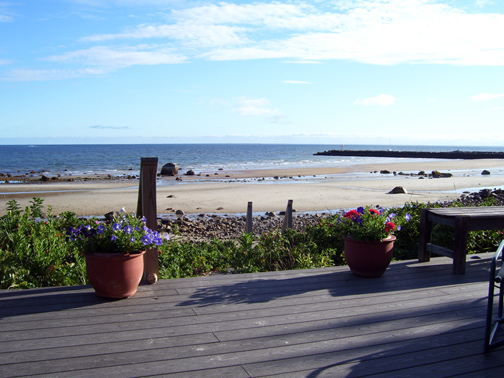 My old friend and fishing buddy Dave has a semi-hemi-demi-cousin who owns a house on the Bay side. She's in her 80's and bought this place 40-some years ago for the then-high sum of about $18,000. A smart move: it's worth about $3 million now. This lady has no kids, and Dave and his family are sort of surrogate children, so they ferry her up and back from her assisted-living home in Connecticut, and spend most of the summer there.
My old friend and fishing buddy Dave has a semi-hemi-demi-cousin who owns a house on the Bay side. She's in her 80's and bought this place 40-some years ago for the then-high sum of about $18,000. A smart move: it's worth about $3 million now. This lady has no kids, and Dave and his family are sort of surrogate children, so they ferry her up and back from her assisted-living home in Connecticut, and spend most of the summer there.
Like virtually every house on the Cape, it's covered with weathered wooden shingles. I don't think there's an actual architectural law that mandates this, but clearly, anything else is Just Not Done. There's a postage-stamp lawn out front, and the back is, quite literally, "on the water." At high tide, the water laps up against her seawall. Tides at the Cape are very large—12 to 14 feet—and when the tide is out, the ocean is 400 yards or more away, exposing The Rock-Bound Coast Of Massachusetts. When it comes in, it's almost on the deck. With a north wind and a spring tide, it IS on the deck. Still, the view is worth the trouble.
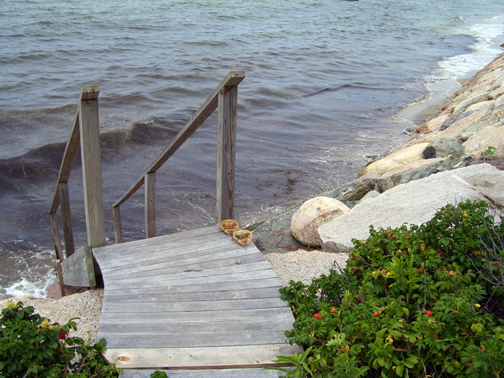 Dave and I have fished together for more than 40 years, so of course I brought fishing tackle. Fishing is what I do when I can't go hunting, and there was no chance of hunting in Massachusetts in the Summer. Not only that, but I had to leave ALL my guns at home, because of the damned laws they have up there. I'm almost always armed and I feel naked without my Kel-Tec in my pocket, but there it is, there wasn't anything I could do about it.
Dave and I have fished together for more than 40 years, so of course I brought fishing tackle. Fishing is what I do when I can't go hunting, and there was no chance of hunting in Massachusetts in the Summer. Not only that, but I had to leave ALL my guns at home, because of the damned laws they have up there. I'm almost always armed and I feel naked without my Kel-Tec in my pocket, but there it is, there wasn't anything I could do about it.
We did go fishing, though not in salt water. Cape Cod is littered with God alone knows how many freshwater ponds: I never knew that until this trip. They're remnants of the Ice Age (the Cape is a giant deposit of glacial till). Gouged out eons ago as the glaciers moved south, they're kept filled by springs and rainfall. The most amazing thing about these ponds is that all of them have public access, by law. The shores are all private land and you can't walk into the ponds through them, but it seems that somehow the People's Republic of Massachusetts mandates an access point to all such waters, and the waters themselves are publicly owned. I'm sure this isn't pleasing to the vast majority of the people who own multi-million-dollar homes on the shores of the ponds, but it's fine by me. Massachusetts does something right, after all. Another thing good at is gouging non-residents for temporary licenses. I had to pay $24 for a 3-day license!
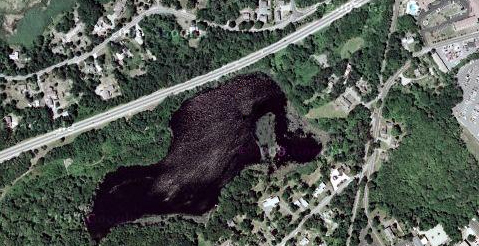 Dave had waxed enthusiastic about a place called Cedar Pond. We went there twice, using his kayak. Now, I'm not a kayaker and had in fact never been in one before. I was a little leery of them, actually, since they seem to be pretty tippy; my Old Town square-stern canoe is stable enough to stand up in, so when Dave started telling me about his kayak, I was glad my life insurance was adequate. It turned out, however, that the thing was surprisingly comfortable (you sit with your legs stretched out) despite having minimal room for gear. I'm used to a real tackle box, but at Cedar Pond I had to pare it down to absolute essentials in a grocery bag. I also discovered what I should have known...an 8-foot rod is a positive nuisance in a kayak. The second day I use a short stream rod I'd had the sense to bring as well.
Dave had waxed enthusiastic about a place called Cedar Pond. We went there twice, using his kayak. Now, I'm not a kayaker and had in fact never been in one before. I was a little leery of them, actually, since they seem to be pretty tippy; my Old Town square-stern canoe is stable enough to stand up in, so when Dave started telling me about his kayak, I was glad my life insurance was adequate. It turned out, however, that the thing was surprisingly comfortable (you sit with your legs stretched out) despite having minimal room for gear. I'm used to a real tackle box, but at Cedar Pond I had to pare it down to absolute essentials in a grocery bag. I also discovered what I should have known...an 8-foot rod is a positive nuisance in a kayak. The second day I use a short stream rod I'd had the sense to bring as well.
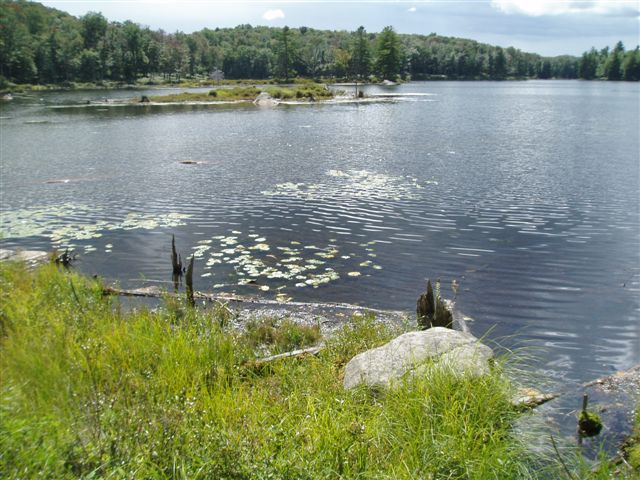 Dave's a believer in the False Doctrine Of Artificial Lures, and had twisted my arm into buying some sort of rubber objects that he insisted were completely irresistible to the monster fish lurking in Cedar Pond. I dutifully bought some and promised to use them, but just in case, I also bought some nightcrawlers at the bait shop where I got stung for my license. The nightcrawlers were only three times the price I'd have paid in Virginia (plus the sales tax) but they proved their worth.
Dave's a believer in the False Doctrine Of Artificial Lures, and had twisted my arm into buying some sort of rubber objects that he insisted were completely irresistible to the monster fish lurking in Cedar Pond. I dutifully bought some and promised to use them, but just in case, I also bought some nightcrawlers at the bait shop where I got stung for my license. The nightcrawlers were only three times the price I'd have paid in Virginia (plus the sales tax) but they proved their worth.
Day One at Cedar Pond, I spent a couple of hours learning how to paddle a kayak, and fruitlessly using those rubber fish. Not a bite did I get, and neither did Dave, though with the zeal of a true believer, he kept using them. After a couple of hours spent chucking refined petroleum products to fish smart enough to ignore them I finally recanted my heresy, returning to The True Doctrine Of Live Bait, with immediate results. I started catching fish. We brought home enough smallmouth and perch to make dinner that night.
I'd been using my standard slip-sinker rig, a setup that produces great results here in the New River and in North Carolina. But I got the impression that I was fishing too deep, so I tried re-rigging without the weight. That improved things somewhat, and I resolved the next day to use that tactic.
Day Two was the clincher. I had a few dozen worms left. I'd simply put one on the hook, toss it as far from the kayak as I could, and it would sink...sink...sink...then WHAM! something would hit it. Usually a perch.
Cedar Pond is the Mother Lode of yellow perch. The second day I must have caught 40 of them, none weighing less than a pound, and most weighing almost two pounds. I also caught two beautiful smallmouth bass—one 17" and one 19"—using the same technique.
We had made arrangements to go to the Cape Cod Playhouse that evening, so we put everything we caught back, though I think it broke Dave's heart to put those bass back in the water. I pointed out that we weren't going to be able to eat them that day, Susan and I were leaving the next morning, and I didn't want to kill them. We hadn't thought to bring a camera with us, and taking them back to the cottage for pictures would be fatal. He managed to choke out a comment on how "noble" it was to release them, but I thought he had to stifle a wail of agony when I let them off the stringer.
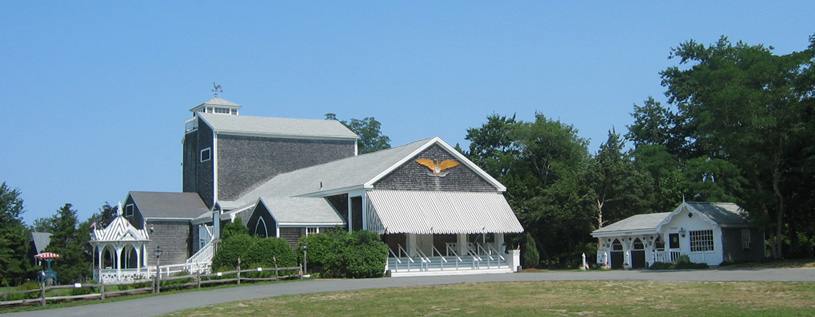
The Cape Cod Playhouse boasts itself as the oldest summer-stock theater in the US, and it may well be: it certainly looks like it. A big barn-like structure built in the 1920's that, frankly, made me nervous. The aisles were narrow, exits few, and the place would have gone up like a Roman Candle in a fire, being built of—what else?—weathered wood. We sat in the balcony, which had a steep aisle (30 degrees, easily!) but no steps! Just a smooth plywood floor. I wonder how many people fall and tumble into the orchestra seats? It would be easy to do.
The performance was a totally inane plot-less musical called "Leader of the Pack," about some 1960's songwriter I never heard of, and her "hits," including one of that name. Clearly a nostalgia thing for aging Baby Boomers who grew up listening to bubble-gum music, and a way for the song writer to milk out some more royalties. Wait until today's teens are in their 60's, there will be nostalgic reviews of their music, too, and I'm glad I won't be here to see them.

 Cape Cod is home to numerous potteries. We went to one, apparently the most famous of them all, Scargo Pottery. These places are devoted to Art. I have included some images of the Art they sell. It's uglier than Hillary Clinton's butt, for the most part, and every piece illustrated here costs between $2000 and $3000, and no, that's not a typo. And the titles in the captions are those given by the Artists who Created this Art. Personally I think they owe Mary Pickford and giraffes everywhere an apology, but they're actually proud of this junk. I have no idea what in the hell this stuff is supposed to "mean," if anything. I suppose it's a Satiric Commentary On The American Condition, but whatever it is, it sure must be Art, because Scargo says so, and who would argue with them? Still less do I understand what kind of person would spend a few kilobucks to have this stuff in the house, but no doubt there are plenty of people with more money than taste (or brains) who buy it. Scargo has been in place and operating for a long time. Maybe the owners have a big trust fund. I have no doubt they get some sort of tax break, too, and probably (almost certainly) grants from the National Endowment For The Arts to produce stupendously ugly stuff like these examples. Your tax dollars at work.
Cape Cod is home to numerous potteries. We went to one, apparently the most famous of them all, Scargo Pottery. These places are devoted to Art. I have included some images of the Art they sell. It's uglier than Hillary Clinton's butt, for the most part, and every piece illustrated here costs between $2000 and $3000, and no, that's not a typo. And the titles in the captions are those given by the Artists who Created this Art. Personally I think they owe Mary Pickford and giraffes everywhere an apology, but they're actually proud of this junk. I have no idea what in the hell this stuff is supposed to "mean," if anything. I suppose it's a Satiric Commentary On The American Condition, but whatever it is, it sure must be Art, because Scargo says so, and who would argue with them? Still less do I understand what kind of person would spend a few kilobucks to have this stuff in the house, but no doubt there are plenty of people with more money than taste (or brains) who buy it. Scargo has been in place and operating for a long time. Maybe the owners have a big trust fund. I have no doubt they get some sort of tax break, too, and probably (almost certainly) grants from the National Endowment For The Arts to produce stupendously ugly stuff like these examples. Your tax dollars at work.
Finally, we headed for the New River Valley again, and something approaching normal and everyday life.
| HUNTING | GUNS | DOGS |
| FISHING & BOATING | TRIP REPORTS | MISCELLANEOUS ESSAYS |
| CONTRIBUTIONS FROM OTHER WRITERS|
| RECIPES |POLITICS |